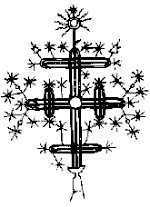Memento of Klimkówka
BEAUTY IS LONG GONE FROM HERE.

The "Gorlice Pieniny" is a name that may not be official or usual, but it has functioned in tourist literature and brochures for a good number of years, in conjunction with one of the most spectacular natural areas in Poland. To the south of the village of Łosie, between the Grybowskie Hills and the Magura Małastowska, the river Ropa has opened up a small canyon, through which a road meanders to UjPcie Gorlickie, and further on to Wysowa - a turn-of-the-century highland rest lodge. The view of the canyon has ensured the use of the name "Pieniny"1. A narrow and convoluted valley stretches for about one kilometer, incorporating steep slopes, which until not too long ago were covered by a fir and beech forest.
The geological sub-strata of the region consists of sedimentary, sandstone, and slate deposits which are a part of the Carpathian geological system. It is therefore not surprising that in the 1930's the area was exploited for its sandstone by the introduction of quarries on the steep slopes of the valley. At that stage the valley was already scarred, but not to the extent that horse-drawn wagons and later motorised transport (including the introduction of a bus route to Wysowa) detracted from the splendid scenery. Mother nature ensured that the majestic scenery recovered sufficiently, as can be seen by the lush covering as well as the popularity of the area with visitors.
This region is also of interest to ethnographers. The village of Klimkówka in the valley had its beginnings in the fifteenth century. The first recorded events in Klimkówka are from the year 1435. In the Lower Beskidy, the indigenous population (the original settlers of the region) was pastoral. With time, assimilation occurred with the Lemko people who were of Russian origin. These two peoples lived in peaceful co-existence until the Second World War, when they were forcibly evicted.
There is no village in this region without a church. Klimkówka was declared a Greco-Catholic parish in 1796. The local Greco-Catholic church was constructed of timber and covered in wooden shingles. It included a bell tower and was surrounded by a wooden fence. Unfortunately, this wooden "stave" church was lost in a fire during the twentieth century. With great effort, the inhabitants of Klimkówka rebuilt a masonry church in 1914, which after 1945 was converted into a Roman Catholic church. To ensure the construction of a masonry church, the inhabitants bore great financial costs. The need for a place of worship was of paramount importance to them. The church was beautiful, incorporating five cupolas which were covered in leaf. On a sunny day, the cupolas glinted in the sun and were visible from a long way off. Through the office of the Regional Building Conservator, which was established in 1973, the building was incorporated into the list of historic buildings of Rzeszów voivodship. In a few words, it was a building that was ideally integrated into the landscape and existed as an element of great value in the surrounding Lemko countryside. Within the village of Klimkówka can be found important ethnographic and historical clues to the surroundings.
People have from time immemorial delighted in looking at and creating beautiful objects. This situation is subject to rapid change when the inhabitants of an area start to thoughtlessly destroy the natural habitat around them, the habitat of which they are part. By destroying the environment around him, a man not only denies himself, but he denies the enjoyment of the area for future generations. This exploitation of nature is usually the result of insignificant factors. We have not halted this wanton destruction of nature, as can be seen from the destruction of the Gorlice Pieniny.
In the 1970's, construction began on a dam in Klimkówka. The church at Klimkówka was demolished on May 27, 1982, while at the same time, in an effort to "level" the site, forty-eight highlander enclosures, a cemetary, a school, a shop, and a blacksmith's workshop were demolished. The valley was ringed by a dam wall 210 meters long, 33 meters high, and incorporating some 430,000 cubic meters of fill, and 61,000 cubic meters of mass concrete, which manifested itself in a massive "memorial" to the inventiveness of the project initiators.
The fact that a dam was built is not in question here. After all, this type of project can be found throughout the world. They can bring a lot of advantages, though not without negative side-effects. But it is almost impossible to find a reason for the construction of this dam in Klimkówka. Reasons just do not exist. The water will not be used by the inhabitants who live in close proximity to the dam, nor will the towns of Gorlice and Jasło have any need for the water, as they have their own adequate supply. In any case, in the event of a greater demand for water in the region, the water from the dam will not be used. Therefore, the argument that the dam was created as a national project to protect the landscape that is situated below the dam just doesn't hold water. Protests by interested parties have attested to this fact. Therefore the only other possible advantage of the dam is for recreational purposes. But it is difficult to understand a number of related factors. The natural integrity of the Gorlice Pieniny, which constitutes a unique fragment of the natural landscape, has been destroyed. The historically significant villages of Lemkos and Klimkówka have essentially been removed from the map in the name of progress and recreation, even though these recreational facilities already existed. It is mind-boggling that it was necessary to destroy what existed just to rebuild it again!
The Department of Water Affairs in Krakow has been looking for areas that are conducive to such large investment schemes. They include all sorts of arguments for and against while they disregard the degradation caused by such schemes. This blatant disregard is only to the detriment of society -- taxpayers' money is being poured into these projects with the result that a common inheritance is being destroyed without want or reason. At the same time, the persons responsible for this devastation have not been held accountable. In fact, they have even been rewarded -- in February, the President announced the awards of Gold and Silver Service Medals to several persons, amongst them seven persons who were responsible for the dam at Klimkówka. The dam is now complete, but will anybody in two years' time remember what existed there before?
On February 21,1994, at the behest of the President of the Republic of Poland, the following awards were conferred for the building of the Klimkówka Dam:
Silver Cross: Władysław Morawa, Andrzej Roskowski. Jerzy Florkowski
Bronze Cross: Paweł Bubka, Roman Chelmecki, Ryszard Krzyczka and Elżbieta Seltenreich.
Reported in: Monitor Polski (no.12 /94) dated 24.02.94.
1From the name of the canyon in the Pieniny Mountains.
picture of the church by Krystyna Antoniak from "Gorlickie" guide







 Wydawnictwo „Zielone Brygady” - dobre z natury. Niektóre prawa zastrzeżone.
Wydawnictwo „Zielone Brygady” - dobre z natury. Niektóre prawa zastrzeżone.